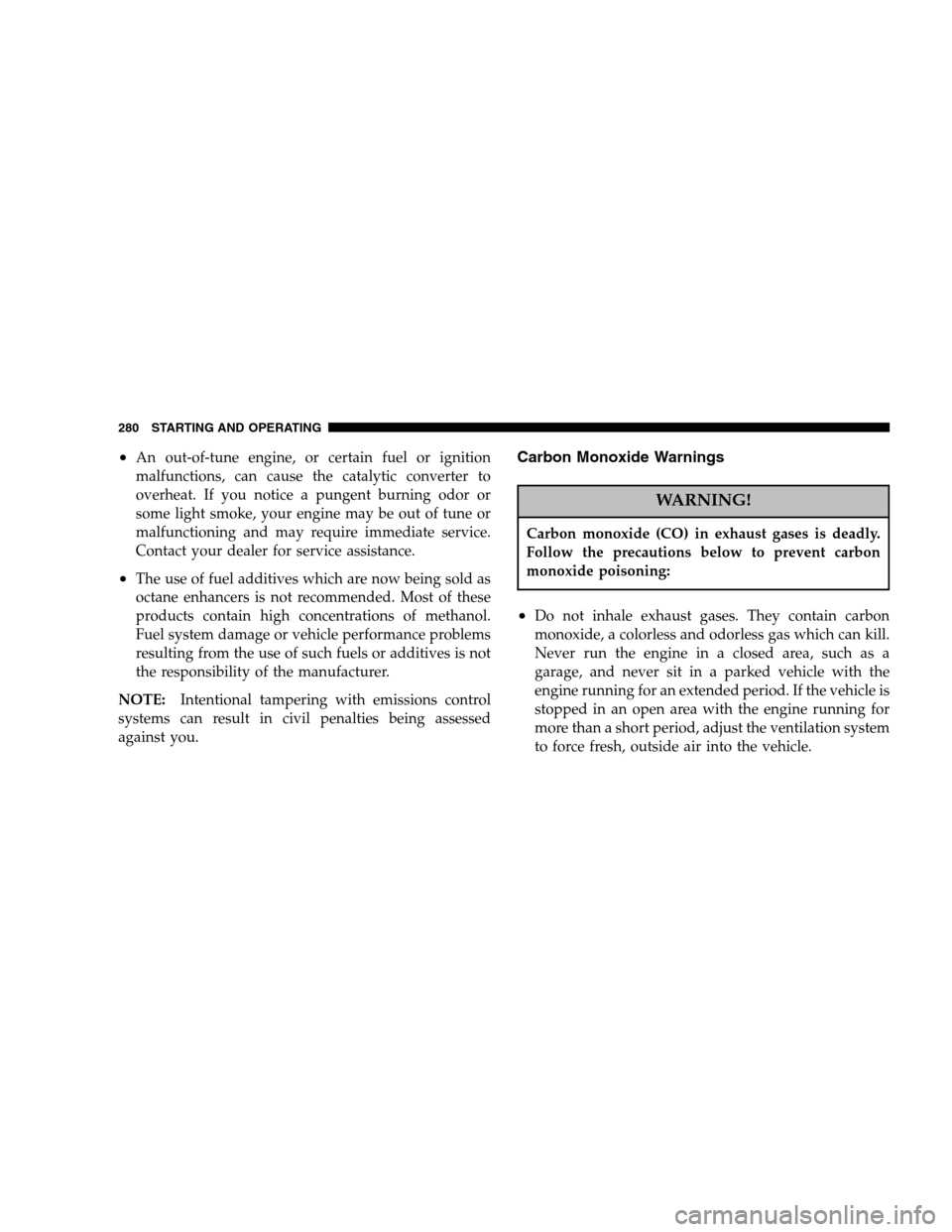Page 278 of 408

Over 40 auto manufacturer’s world wide have issued and
endorsed consistent gasoline specifications (the World-
wide Fuel Charter, WWFC) to define fuel properties
necessary to deliver enhanced emissions, performance,
and durability for your vehicle. The manufacturer recom-
mends the use of gasoline that meets the WWFC speci-
fications if they are available.
Reformulated Gasoline
Many areas of the country require the use of cleaner
burning gasoline referred to as Reformulated Gasoline.
Reformulated gasoline contains oxygenates, and is spe-
cifically blended to reduce vehicle emissions and im-
prove air quality.
The manufacturer strongly supports the use of reformu-
lated gasoline. Properly blended reformulated gasoline
will provide excellent performance and durability for the
engine and fuel system components.
Gasoline/Oxygenate Blends
Some fuel suppliers blend unleaded gasoline with oxy-
genates such as 10% ethanol, MTBE, and ETBE. Oxygen-
ates are required in some areas of the country during the
winter months to reduce carbon monoxide emissions.
Fuels blended with these oxygenates may be used in
your vehicle.
CAUTION!
DO NOT use gasoline containing METHANOL.
Gasoline containing methanol may damage critical
fuel system components.
278 STARTING AND OPERATING
Page 280 of 408

•An out-of-tune engine, or certain fuel or ignition
malfunctions, can cause the catalytic converter to
overheat. If you notice a pungent burning odor or
some light smoke, your engine may be out of tune or
malfunctioning and may require immediate service.
Contact your dealer for service assistance.
•The use of fuel additives which are now being sold as
octane enhancers is not recommended. Most of these
products contain high concentrations of methanol.
Fuel system damage or vehicle performance problems
resulting from the use of such fuels or additives is not
the responsibility of the manufacturer.
NOTE:Intentional tampering with emissions control
systems can result in civil penalties being assessed
against you.
Carbon Monoxide Warnings
WARNING!
Carbon monoxide (CO) in exhaust gases is deadly.
Follow the precautions below to prevent carbon
monoxide poisoning:
•Do not inhale exhaust gases. They contain carbon
monoxide, a colorless and odorless gas which can kill.
Never run the engine in a closed area, such as a
garage, and never sit in a parked vehicle with the
engine running for an extended period. If the vehicle is
stopped in an open area with the engine running for
more than a short period, adjust the ventilation system
to force fresh, outside air into the vehicle.
280 STARTING AND OPERATING
Page 317 of 408

The best time to check the engine oil level is about 5
minutes after a fully warmed engine is shut off or before
starting the engine after it has sat overnight.
Checking the oil while the vehicle is on level ground will
improve the accuracy of the oil level readings. Maintain
the oil level in the SAFE level range. Adding 1 U.S. Quart
(0.95L) of oil when the level is at the bottom of the SAFE
range will result in the level being at the top of the SAFE
range.
CAUTION!
Overfilling or underfilling the crankcase will cause
aeration or loss of oil pressure. This could damage
your engine.
Change Engine Oil
Road conditions as well as your kind of driving affect the
interval at which your oil should be changed. Check the
following to determine if any apply to you:
•Day or night temperatures are below 32°F (0°C)
•Stop and go driving
•Extensive engine idling
•Driving in dusty conditions
•Short trips of less than 10 miles (16.2 km)
•More than 50% of your driving is at sustained high
speeds during hot weather, above 90°F (32°C)
•Trailer towing
•Taxi, Police, or delivery service (Commercial Service)
•Off road or desert operation
•If equipped for and operating with E-85 (ethanol) fuel
MAINTAINING YOUR VEHICLE 317
7
Page 363 of 408

•Off-road or desert driving
•If equipped for and operated with E-85 (ethanol)
fuel.
NOTE:Most vehicles are operated under the conditions
listed for Schedule “B.”
NOTE:IfANYof these apply to you, change your
engine oil every 3,000 miles (5 000 km) or 3 months,
whichever comes first, and follow the maintenance rec-
ommendations in “Maintenance Schedule B.”
NOTE:IfANYof these apply to you then flush and
replace your engine coolant every 102,000 miles (163 000
km) or 60 months, whichever comes first, and follow
“Schedule B” of the “Maintenance Schedules” section of
this manual.
Second is Schedule“A”. It is for vehicles that are not
operated under any of the conditions listed under Sched-
ule “B.”Use the schedule that best describes your driving condi-
tions. Where time and mileage are listed, follow the
interval that occurs first.
CAUTION!
Failure to perform the required maintenance items
may result in damage to the vehicle.
At Each Stop for Fuel
•Check the engine oil level about 5 minutes after a fully
warmed engine is shut off. Checking the oil level while
the vehicle is on level ground will improve the accu-
racy of the oil level reading. Add oil only when the
level is at or below the ADD or MIN mark.
•Check the windshield washer solvent, add as required.
MAINTENANCE SCHEDULES 363
8
M
A
I
N
T
E
N
A
N
C
E
S
C
H
E
D
U
L
E
S
Page 365 of 408

Schedule “B”
Follow this schedule if you usually operate your vehicle
under one or more of the following conditions.
•Day or night temperatures are below 32°F (0°C)
•Stop and go driving
•Excessive engine idling
•Driving in dusty conditions
•Short trips of less than 10 miles (16.2 km)
•More than 50% of your driving is at sustained high
speeds during hot weather, above 90°F (32°C)
•Trailer towing
•Taxi, police, or delivery service (commercial service)
•Off-road or desert driving
•If equipped for and operated with E-85 (ethanol)
fuel.
NOTE:IfANYof these apply to you, change your
engine oil every 3,000 miles (5 000 km) or 3 months,
whichever comes first, and follow the maintenance rec-
ommendations in “Maintenance Schedule B.”
NOTE:IfANYof these apply to you then flush and
replace your engine coolant every 102,000 miles (163 000
km) or 60 months, whichever comes first, and follow
“Schedule B” of the “Maintenance Schedules” section of
this manual.
SCHEDULE “B” 365
8
M
A
I
N
T
E
N
A
N
C
E
S
C
H
E
D
U
L
E
S